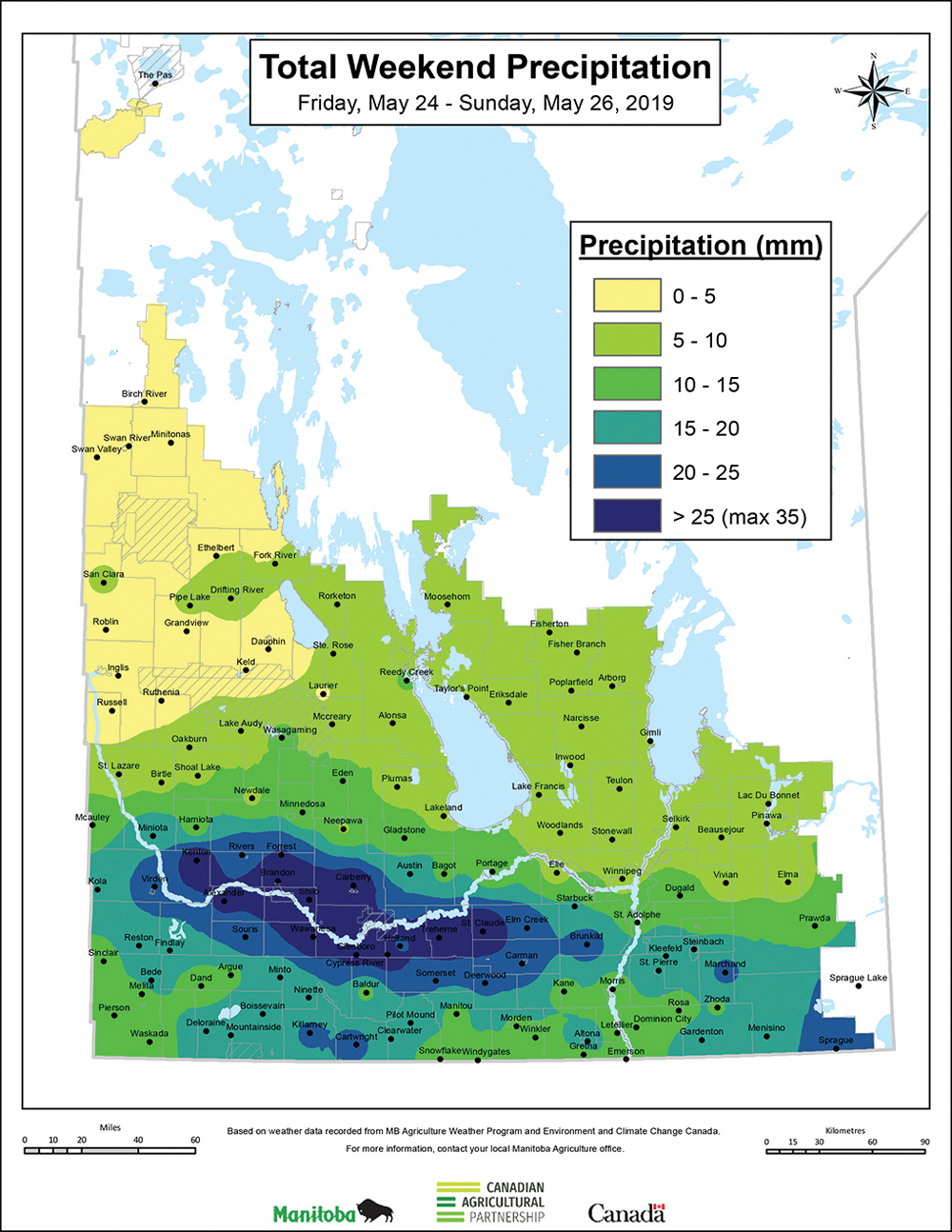Farmers and crop insurance appreciated the rain late last week but not the frost.
As of press time Monday farmers and agronomists across much of agro-Manitoba were assessing what, if any damage, below-freezing temperature had on crops early May 27.
Manitoba Agriculture weather stations recorded below-freezing temperatures in most regions, with the central region seeing the least coldest and for the shortest duration.
The northwest, southwest, Interlake and eastern regions were generally much colder a longer time.
For example, the low at Grandview in the northwest was -4.6 C, with below-freezing temperatures for eight hours, Beausejour in eastern region bottomed at -3.9 C and was below freezing for six hours and Fisherton in the Interlake and Argue in the southwest went to -3.8 C and were below 0 C for six and seven hours, respectively.
Gladstone recorded the lowest temperature — -2.3 C — in the central region.
That station recorded freezing temperatures for six hours.
Many other central stations were just below zero for varying lengths of time.
“We got a couple of panicky farmers calling, but right now we’re fielding calls and we have hardly any claims registered at this point,” David Koroscil, Manitoba Agricultural Services Corporation’s manager of claim services said Monday morning. “Obviously they are waiting to see if it’s worth registering a claim or not.”
The silver lining to this spring’s cool weather is that many frost-susceptible crops, including soybean and edible beans, haven’t emerged yet, he added.
“Frost did touch down in large areas of the province last night, but (it) might not have been severe enough to damage the growing points of some canola,” Manitoba Agriculture’s oilseed specialist Dane Froese said in an email Monday. “Wait to evaluate in three days, (and see) if new leaves are still emerging.”
Read Also

How much nitrogen can farmers really cut?
Manitoba fertilizer trials look for nitrification inhibitor sweet spot, to lower greenhouse gas emissions and cost without hurting yield.
Proximity to the ground may have offered some protection for seedlings, Manitoba Agriculture farm production specialist Lionel Kaskiw said.
“The soil surface never seems to get quite as cold as the air temperature because once the ground heats up, it takes a little bit longer for it to cool down again,” he told the <Manitoba Co-operator> in an interview May 27. “A lot of those plants are probably going to be OK. Again, it’s going to be field by field, so we’re definitely going to be urging people to be going out and checking their fields.”
Cool temperatures, which Manitoba has had this spring, can harden some early crops making them better able to withstand frost, Manitoba Agriculture’s website says.
Cereals and peas are known for their frost tolerance and ability to regrow if frozen during the early stages of development.
Much of agro-Manitoba received rain Friday night, Saturday night and Sunday morning, which could help. Moist soil conditions help buffer the crop from air temperature changes as they cool more slowly than dry soils.
Over an inch of rain was falling in some places.
Soil moisture five centimetres down in Glenboro sat at over 30 per cent May 27, the first time since mid-May that moisture at that depth rose above 20 per cent.
Manitoba Agriculture has reported similar trends in Steinbach and other areas in southern Manitoba.
Manitoba Agriculture noted the most rainfall in a band along the Assiniboine River.
Timi Ojo, agro-meteorologist with Manitoba Agriculture, said the rains were much needed, but were not evenly distributed and did not bring as much moisture to some regions as anticipated.
“From the Kenton area all the way to, say, St. Adolphe and to the Red River and farther to the east, they actually got a pretty good dump,” he said. “Not so much though closer to the Saskatchewan border.”
The far southwest saw far less rain than forecast, Ojo said, with areas around Pierson and Melita only recording 10 to 20 millimetres.
Soil moisture in Pierson still sat at 11 per cent five centimetres down as of May 27. Soil moisture had hovered below six per cent prior to the rains.
Areas around Russell and north through the Parkland were not forecast to see much rain, however, Ojo pointed out.
Much of the Interlake, likewise, saw little precipitation.
Little rain fell in north of the Trans-Canada Highway, according to Kaskiw.
“The rain is definitely something that everybody wanted, so I think everybody was pretty happy to see it,” Kaskiw said.
“As we go on here, we’re going to need some more, definitely, but it was something that’s definitely going to get the crop germinated, especially this later-seeded canola that was sown into some dust in a lot of places,” he added.

















